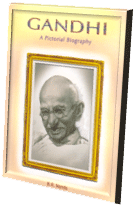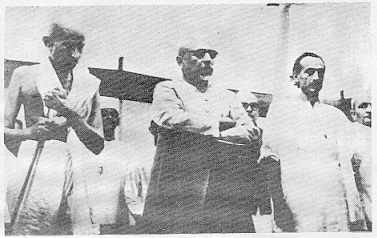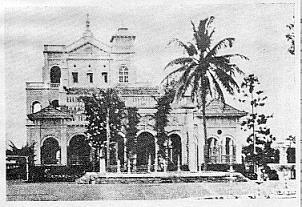
P.O. SEVAGRAM, DIST.WARDHA 442102, MS, INDIA. Phone: 91-7152-284753
FOUNDED BY MAHATMA GANDHI IN 1936
BIOGRAPHY OF GANDHI
GANDHI - A PICTORIAL BIOGRAPHY
by Shri B. R. Nanda

GANDHI
- A PICTORIAL BIOGRAPHY
Shri B. R. Nanda
Table of Contents
- About Gandhi
- Childhood
- Off To England
- Briefless Barrister
- In The 'Dark Continent'
- The Young Politician
- Satyagraha Struggle In South Africa
- The Making Of The Mahatma
- Return To India
- Gandhi's Ashram
- World War I
- Rowlatt Bills
- Nonviolent Non-cooperation
- Arrest And Imprisonment
- Reaction And Recovery
- Declaration Of Complete Independence
- Gandhi-Irwin Pact
- Round Table Conference
- In London
- Resumption Of Struggle
- Campaign Against Untouchability
- A New Deal For The Village
- The New Constitution
- Hindu-Muslim Antagonism
- Nonviolence In A Violent World
- Cripps Mission
- "Quit India"
- Simla Conference
- Cabinet Mission
- Communal Conflagration
- Partition of India
- Mission of Peace
- The End
- Gandhi and Nonviolence
About This Book
This is the first pictorial biography of Gandhi in which the narrative-concise, readable and incisive is illustrated with contemporary photographs and facsimiles of letters, newspaper reports and cartoons, adding up to a fascinating flash-back on the life of Mahatma Gandhi and the struggle for Indian freedom led by him. There is a skilful matching in this book of text and illustrations, of description and analysis and of concrete detail and large perspective. This pictorial biography will revive many memories in those who have lived through the Gandhian era; it should also be of interest to the post-independence generation.
About Author
Shri B. R. Nanda - former Director, Nehru Memorial Museum and Library, New Delhi. His full-scale biography of Mahatma Gandhi has been published in India, Britain and the U.S.A. and translated into French, Spanish, Italian and several other languages
Chapter-26 : "Quit India"


2. The Aga Khan Palace near Poona, where Gandhi was interned from August 1942 to May 1944
The "Quit India" resolution passed by the All-India Congress Committee brought it into a head-on collision with the Government in August 1942. The Viceroy, with the strong backing of the British Cabinet, struck hard. Gandhi, Nehru and almost all the Congress leaders were imprisoned; the severest repression was launched against the Congress - its funds were frozen offices sealed and publicity media plugged. This "blitzkrieg" had violent repercussions. In the last speech before the All-India Congress Committee before his arrest, Gandhi had made non-violence the basic premise of the struggle which he proposed to launch; this advice remained unheeded between the frenzy of the people and the hammer blows of the Government. In several parts of the country, in Bihar, in U. P., in Bengal and in Bombay, the fury of the people burst the dykes and turned on the instruments and symbols of British rule. "The Congress Party", Churchill told the House of Commons, "has now abandoned the policy which Mr. Gandhi had so long inculcated in theory and has come into the open as a revolutionary movement." In India and abroad official propaganda attributed violence to a plot carefully laid by Congress leaders. Gandhi was even accused of being pro-Axis, and assisting a Japanese conquest of India. Official propaganda held the field for a time, but not for long. "It is sheer nonsense," Smuts, Gandhi's old antagonist in South Africa, told a press conference in London in November 1942, "to talk of Mahatma Gandhi as a fifth columnist. He is a great man. He is one of the great men of the world."
Mahadev Desai, who had served as Gandhi's secretary for 25 years, died of a heart attack within a week of his imprisonment and Kasturba, the Mahatma's wife, passed away in 1944 after a long illness. Early in 1944, his health began to cause concern to the Government. He had contracted malaria and had been running a high temperature. The tide of the war had already turned in favour off the Allies, and the risks of his release seemed to the Government immeasurably less than those of his possible death in jail.
After his release in May 1944, Gandhi tried to break the political deadlock. Neither Churchill, who still headed the British Cabinet, nor Jinnah, who had the commanding voice in the counsels of the Muslim League, seemed eager for a political detente. The British seemed reluctant to part with power, and the Muslim League evidently was waiting for an opportunity for driving a harder bargain. A formula suggested by C. Rajagopalachari, which Gandhi discussed with Jinnah, conceded the substance of the Muslim League's demand for Pakistan, but the offer was turned down by the League leader.